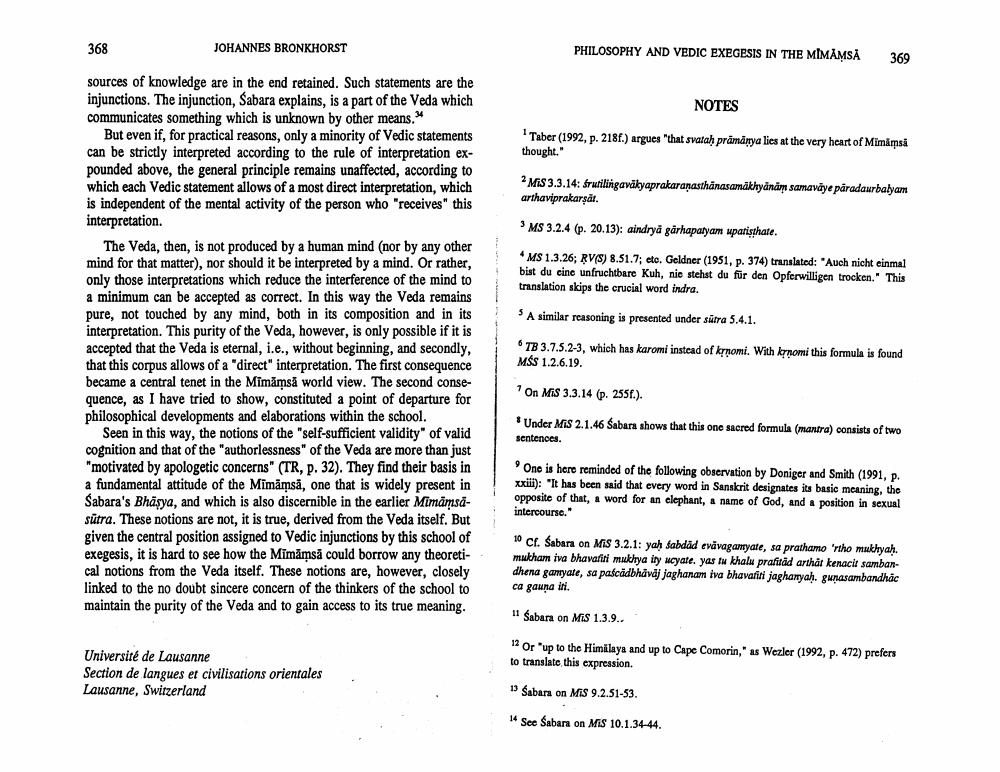Book Title: Philosophy And Vedic Exegesis In Mimamsa Author(s): Johannes Bronkhorst Publisher: Johannes Bronkhorst View full book textPage 6
________________ 368 JOHANNES BRONKHORST PHILOSOPHY AND VEDIC EXEGESIS IN THE MIMAMSÅ 369 NOTES Taber (1992, p. 218f.) argues that svataḥ prāmänya lies at the very heart of Mimamsa thought." 2 MIS 3.3.14: Srurilingavikyaprakaranasthānasamdkhyanam samaväye påradaurbalyam arthaviprakarsát. MS 3.2.4 (p. 20.13): aindrya gärhapatyam uparisthate. • MS 1.3.26; RV(S) 8.51.7; cto. Geldner (1951, p. 374) translated: "Auch nicht einmal bist du eine unfruchtbare Kuh, nie stehst du für den Opferwilligen trocken." This translation skips the crucial word indra. SA similar reasoning is presented under sütra 5.4.1. sources of knowledge are in the end retained. Such statements are the injunctions. The injunction, Sabara explains, is a part of the Veda which communicates something which is unknown by other means." But even if, for practical reasons, only a minority of Vedic statements can be strictly interpreted according to the rule of interpretation expounded above, the general principle remains unaffected, according to which each Vedic statement allows of a most direct interpretation, which is independent of the mental activity of the person who "receives" this interpretation The Veda, then, is not produced by a human mind (nor by any other mind for that matter), nor should it be interpreted by a mind. Or rather, only those interpretations which reduce the interference of the mind to a minimum can be accepted as correct. In this way the Veda remains pure, not touched by any mind, both in its composition and in its interpretation. This purity of the Veda, however, is only possible if it is accepted that the Veda is eternal, i.e., without beginning, and secondly, that this corpus allows of a "direct" interpretation. The first consequence became a central tenet in the Mimāmsā world view. The second consequence, as I have tried to show, constituted a point of departure for philosophical developments and elaborations within the school. Seen in this way, the notions of the "self-sufficient validity of valid cognition and that of the "authorlessness" of the Veda are more than just "motivated by apologetic concerns" (TR, p. 32). They find their basis in a fundamental attitude of the Mīmāmsă, one that is widely present in Sabara's Bhäsya, and which is also discernible in the earlier Mimāņsāsūtra. These notions are not, it is true, derived from the Veda itself. But given the central position assigned to Vedic injunctions by this school of exegesis, it is hard to see how the Mimāmsă could borrow any theoretical notions from the Veda itself. These notions are, however, closely linked to the no doubt sincere concern of the thinkers of the school to maintain the purity of the Veda and to gain access to its true meaning. 6 TB 3.7.5.2-3, which has karomi instead of kinomi. With knomi this formula is found MÁS 1.2.6.19. On Mis 3.3.14 (p. 255f.). Under MIS 2.1.46 Sabara shows that this one sacred formula (mantra) consists of two sentences. One is here reminded of the following observation by Doniger and Smith (1991, p. xxiii): "It has been said that every word in Sanskrit designates its basic meaning, the opposite of that, word for an elephant, a name of God, and a position in sexual intercourse." 10 ct. Sabara on Mis 3.2.1: yah Sabdad evavaganyate, sa prathamo'rtho mukhyah. mukham iva bhavariti mukoya ity Meyate. yas tu khalu prafitad arthar kenacit sambandhena ganyate, sa pafcädbhawaj jaghanam iva bhavariti jaghanyah, gunasambandhac ca gauna ini. 11 Sabara on MES 1.3.9. - 12 Or "up to the Himalaya and up to Cape Comorin," as Wezler (1992, p. 472) prefers to translate this expression. Université de Lausanne Section de langues et civilisations orientales Lausanne, Switzerland 19 Sabara on MIS 9.2.51-53. 14 See Sabara on Mis 10.1.34-44.Page Navigation
1 ... 4 5 6 7
